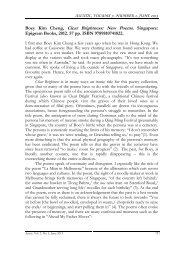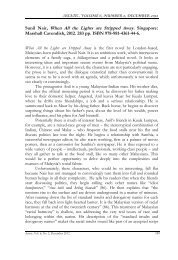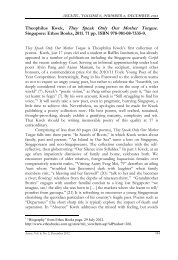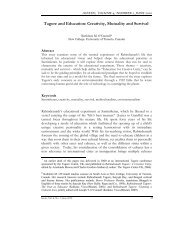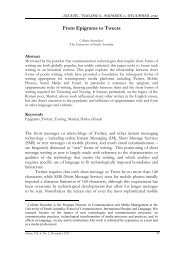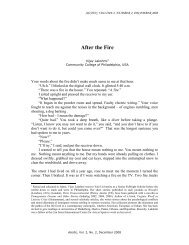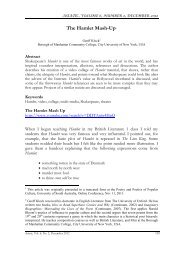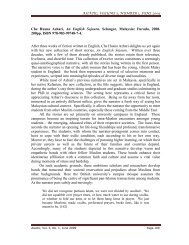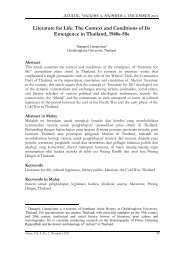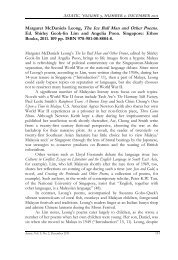“New Woman” in Rabindranath Tagore's Short Stories: An ... - Asiatic
“New Woman” in Rabindranath Tagore's Short Stories: An ... - Asiatic
“New Woman” in Rabindranath Tagore's Short Stories: An ... - Asiatic
You also want an ePaper? Increase the reach of your titles
YUMPU automatically turns print PDFs into web optimized ePapers that Google loves.
ASIATIC, VOLUME 4, NUMBER 2, DECEMBER 2010<br />
<strong>“New</strong> <strong>Woman”</strong> <strong>in</strong> Rab<strong>in</strong>dranath Tagore’s <strong>Short</strong> <strong>Stories</strong>: <strong>An</strong><br />
Interrogation of “Laboratory”<br />
Bharati Ray 1<br />
University of Calcutta, India<br />
Abstract<br />
This article <strong>in</strong>vestigates Rab<strong>in</strong>dranath Tagore‟s perspectives on women as seen through<br />
his short stories. While his poems primarily describe beauty, nature and his search for<br />
what is beyond mundane life, his short stories deal with the lives of ord<strong>in</strong>ary people.<br />
Women‟s struggles and suffer<strong>in</strong>gs are particularly highlighted. This article argues that<br />
while on one hand Tagore reveals the unequal social structure that oppresses women,<br />
on another, he creates courageous women who challenge tradition. His short story<br />
“Laboratory,” written a few months before his death, expresses his latest views on<br />
women and gives shape to the “new woman,” whom he perceives as arriv<strong>in</strong>g <strong>in</strong> India <strong>in</strong><br />
the near future. In so do<strong>in</strong>g, Tagore urges women to f<strong>in</strong>d an identity of their own, and<br />
realise that wifehood and motherhood are but fractions of their whole be<strong>in</strong>g.<br />
Abstract <strong>in</strong> Malay<br />
Artikel <strong>in</strong>i mengkaji pandangan Rab<strong>in</strong>dranath Tagore terhadap wanita seperti yang<br />
dilihat menerusi cerpen-cerpennya. Sewaktu puisi-puisi beliau mengutarakan ke<strong>in</strong>dahan,<br />
alam semulajadi dan pencariannya melangkaui hidup yang membosankan, cerpencerpen<br />
beliau sebaliknya menyentuh hidup orang kebanyakan, terutamanya penderitaan<br />
dan usaha keras wanita. Artikel <strong>in</strong>i memb<strong>in</strong>cangkan bagaimana dari satu segi, Tagore<br />
mendedahkan ketidakadilan struktur masyarakat yang men<strong>in</strong>das wanita, dan dari segi<br />
yang la<strong>in</strong>, mencipta wanita-wanita berani yang mencabar tradisi. Cerpen beliau<br />
“Laboratory,” ditulis beberapa bulan sebelum kematiannya, mengutarakan pandangan<br />
terk<strong>in</strong>i terhadap wanita dan mencetuskan konsep “wanita baru,” yang dilihat Tagore<br />
sebagai akan wujud di India dalam masa terdekat. Oleh yang demikian, Tagore<br />
menggalakkan wanita untuk mencari identiti mereka sendiri dan menyedari bahawa<br />
menjadi isteri dan ibu hanyalah sebahagian daripada keseluruhan peranan mereka.<br />
Keywords<br />
Tagore, short stories, new woman, identity, wifehood, motherhood<br />
1 Bharati Ray served as Professor of History at Calcutta University, India and as the University’s<br />
Pro-Vice Chancellor. She is currently the Vice President of Indian Council for Cultural Relations.<br />
A bil<strong>in</strong>gual author, Ray has published several authored/edited books <strong>in</strong>clud<strong>in</strong>g From the Seams of<br />
History: Essays on Indian Women, Early Fem<strong>in</strong>ists <strong>in</strong> Colonial India: Sarala Devi Chaudhurani<br />
and Begum Rokeya Sakhawat Hossa<strong>in</strong>, Women of India: Colonial and Post-Colonial Periods and<br />
Different Types of History. She has compiled and edited two volumes of articles published <strong>in</strong> the<br />
earliest women’s journal <strong>in</strong> Bengal, Bamabodh<strong>in</strong>i Patrika (1863-1922).<br />
<strong>Asiatic</strong>, Vol. 4, No. 2, December 2010 68
Keywords <strong>in</strong> Malay<br />
Tagore, cerpen, wanita baru, identiti, isteri, ibu<br />
<strong>“New</strong> <strong>Woman”</strong> <strong>in</strong> Rab<strong>in</strong>dranath Tagore’s <strong>Short</strong> <strong>Stories</strong><br />
Introduction<br />
Rab<strong>in</strong>dranath Tagore (1861-1941) was a “myriad-m<strong>in</strong>ded man” (Dutta and<br />
Rob<strong>in</strong>son 1). He wrote extensively <strong>in</strong> various creative genres, e.g. poetry, drama,<br />
fiction and non-fictional prose; composed numerous songs; pa<strong>in</strong>ted over 3,000<br />
pictures; thought about rural reconstruction, environment and nature; took an<br />
<strong>in</strong>terest <strong>in</strong> science, and established a university <strong>in</strong> West Bengal. Critics have<br />
written so much on so many aspects of Rab<strong>in</strong>dranath that it is hard to discover<br />
an area to write on. <strong>An</strong>d yet not much has been written on his thoughts on<br />
women, although he wrote extensively about them. This paper proposes to<br />
explore his vision and views on women as reflected <strong>in</strong> his short stories.<br />
However, <strong>in</strong> this brief article, my focus will be limited to only one of the 119<br />
stories he wrote, “Laboratory.” My selection of this particular story is based on<br />
two considerations. First, its historical importance <strong>in</strong> the context of the time it<br />
was written. Published <strong>in</strong> September-October 1940, about a year before the<br />
writer passed away <strong>in</strong> August 1941, it was practically one of his last stories.<br />
Second, by the time he wrote the story, Rab<strong>in</strong>dranath had devoted considerable<br />
thought to women. Women had been at the core of his many poems, songs,<br />
essays and pa<strong>in</strong>t<strong>in</strong>gs. “Laboratory” marks his matured and almost his last<br />
deliberation on women. When published, it dazzled the readers and created a<br />
stir among the admirers of literature.<br />
While Rab<strong>in</strong>dranath was never comfortable with strident assertions of<br />
women‟s rights, and was not k<strong>in</strong>d to those who were known as fem<strong>in</strong>ists<br />
(Tagore, Chithipatra), he showed a remarkable understand<strong>in</strong>g of woman‟s<br />
psyche, perceived the <strong>in</strong>justice of an unequal social structure, and advocated for<br />
greater freedom and decision-mak<strong>in</strong>g power for women <strong>in</strong> the family and the<br />
larger society. In addition to his remarkable stories about young girls (of which<br />
“The Postmaster” is a masterpiece), Tagore‟s short stories can be seen as<br />
represent<strong>in</strong>g three facets of women‟s lives: i) the romance between men and<br />
women, ii) social oppression of women (brilliantly portrayed <strong>in</strong> stories like<br />
“Haimanti”) and iii) the birth of the “new woman” – that is, a woman who<br />
challenges convention and seeks to make decisions about her own life. It is the<br />
third theme only that this paper is concerned with.<br />
In Rab<strong>in</strong>dranath‟s early th<strong>in</strong>k<strong>in</strong>g, women had two pr<strong>in</strong>cipal roles –<br />
mother and lover (Pal, Vol. 5: 237). The lov<strong>in</strong>g nature of mother has been<br />
portrayed <strong>in</strong> many of his stories; <strong>An</strong>andamoyee <strong>in</strong> Gora, Jat<strong>in</strong>‟s aunt <strong>in</strong> “Shesher<br />
Ratri” (The Last Night) and Rasmoni <strong>in</strong> “Rasmonir Chhele” (Rasmoni‟s Son)<br />
are a few examples. Romantic love between a man and a woman is the basis of<br />
his stories such as “Dalia” and “Joy Parajoy” (Victory and Defeat). However,<br />
<strong>Asiatic</strong>, Vol. 4, No. 2, December 2010 69
Bharati Ray<br />
women‟s role as lovers has received primacy <strong>in</strong> his poems. In Sonar Tori and<br />
Chitra romanticism dom<strong>in</strong>ates, and the beautiful woman f<strong>in</strong>ds her ultimate<br />
expression <strong>in</strong> the poem “Urvashi”:<br />
For ages you have been the world‟s lover,<br />
Oh you, Urvashi of unparalleled beauty<br />
(“Urvashi,” Rab<strong>in</strong>dra Rachanabali, Vol.1: 511). 2<br />
In an article <strong>in</strong> Prabasi, Kazi Abdul Wadud suggested, “Rab<strong>in</strong>dranath‟s<br />
expressions have two dist<strong>in</strong>ct aspects to it: that of a mystical player of the flute,<br />
and of a visionary (Wadud, Prabasi 497). Even though his visionary perceptions<br />
have been reflected <strong>in</strong> many of his poetical writ<strong>in</strong>gs, such as Chaitali, Naivedya<br />
Palataka, Kheya and Gitanjali, I believe the visionary <strong>in</strong> him has found its fullest<br />
expressions <strong>in</strong> his prose literature, i.e. essays, letters, novels and short stories.<br />
Of these, my focus is only on short stories. In a forthcom<strong>in</strong>g article, I have<br />
reviewed some of his short stories from Galpaguchha, such as “Shasti”<br />
(Punishment), “Streer Patra” (A Wife‟s Letter), “Aparichita” (The Unfamiliar<br />
Woman), “Badnam” (Ill Repute) and “Nashtoneer” (The Broken Home), and<br />
argued that <strong>in</strong> addition to the roles of mother and lover which Tagore attributed<br />
to women, he had discovered another facet of women as well. He did not give it<br />
a name, but we know what it was. It was the “new woman” <strong>in</strong> a new age. My<br />
aim <strong>in</strong> this essay is to exam<strong>in</strong>e this particular image of woman envisioned by<br />
Rab<strong>in</strong>dranath and to do so I have selected just one story: “Laboratory.”<br />
“Laboratory” is not <strong>in</strong>cluded <strong>in</strong> his well-known collection of short stories,<br />
Galpaguchha (A Bouquet of <strong>Stories</strong>). It is <strong>in</strong>cluded <strong>in</strong> his book Teen Sangee (Three<br />
Companions). Accord<strong>in</strong>g to Pramatha Nath Bishi, Tagore‟s writ<strong>in</strong>gs <strong>in</strong> the last<br />
phase of his life <strong>in</strong>creas<strong>in</strong>gly gave calls for liberation of the <strong>in</strong>dividual:<br />
He has repeatedly sent forth summons to free <strong>in</strong>dividuals from bondages<br />
overcom<strong>in</strong>g hurdles. At one end of this <strong>in</strong>vocation for women is the poem<br />
“Mukti” and at the other end are stories like “Haldar Goshthi” (The<br />
Haldar Clan), “Streer Patra,” “Poila Number” (Number One), etc. The last<br />
such <strong>in</strong>vocation is <strong>in</strong> the story “Laboratory.” (Bishi, Rab<strong>in</strong>dra Sarani 236)<br />
To comprehend fully the ma<strong>in</strong> theme of Tagore‟s constantly evolv<strong>in</strong>g thoughts<br />
on women, we will first need to turn to his time.<br />
The Era of Rab<strong>in</strong>dranath<br />
Born <strong>in</strong> 1861 <strong>in</strong>to an illustrious family, Rab<strong>in</strong>dranath grew up <strong>in</strong> the heart of<br />
Calcutta. He came of age at a time when the currents of three movements had<br />
reached the shores of India: i) the religious: Rammohan Roy had founded the<br />
2 All translations from Bengali are m<strong>in</strong>e.<br />
<strong>Asiatic</strong>, Vol. 4, No. 2, December 2010 70
<strong>“New</strong> <strong>Woman”</strong> <strong>in</strong> Rab<strong>in</strong>dranath Tagore’s <strong>Short</strong> <strong>Stories</strong><br />
Brahmo Samaj (1828), which had a profound impact on a section of bhadrolok<br />
community, <strong>in</strong>clud<strong>in</strong>g Tagore‟s family; ii) the literary: “a literary revolution” had<br />
been pioneered, especially <strong>in</strong> Bengal, by the charismatic writer Bankimchandra;<br />
and iii) the political: a nationalist movement had started “to give voice” to<br />
Indian people‟s discontent aga<strong>in</strong>st colonial rule. The poet‟s m<strong>in</strong>d and<br />
sensibilities were shaped by these <strong>in</strong>fluences (Das Gupta 8-10).<br />
Rab<strong>in</strong>dranath lived for eighty eventful years <strong>in</strong> colonial Bengal, and his<br />
views about women changed over time. There were fast changes <strong>in</strong> India which<br />
<strong>in</strong>evitably left a footpr<strong>in</strong>t on his writ<strong>in</strong>gs. <strong>An</strong>y modern history book will tell us<br />
of the shifts <strong>in</strong> political, economic and social circumstances from the middle of<br />
the n<strong>in</strong>eteenth to the 1940s. There is no need to go <strong>in</strong>to all the details. I will<br />
conf<strong>in</strong>e my discussion only to the realm of literary developments <strong>in</strong> Bengal.<br />
When Rab<strong>in</strong>dranath was born, the elements of romance found <strong>in</strong><br />
European literature had become a pervasive theme <strong>in</strong> Bengali creative writ<strong>in</strong>g<br />
(Sen 378). It was Bankimchandra Chattopadhyay (1838-94), who had<br />
<strong>in</strong>troduced the concept of romantic love <strong>in</strong>to Bengali literature. Rab<strong>in</strong>dranath<br />
took the romantic tradition to great heights. Although Rab<strong>in</strong>dranath dom<strong>in</strong>ated<br />
the literary field <strong>in</strong> Bengal, other major writers, such as Sarat Chandra<br />
Chattopadhyay (1876-1938) and Kazi Nazrul Islam (1898-1976) also appeared<br />
dur<strong>in</strong>g his time. In the mid-1920‟s, there emerged a powerful group of younger<br />
writers, who considered themselves modernists and gathered around the<br />
journal, Kallol. Although admir<strong>in</strong>g of Rab<strong>in</strong>dranath, this group tried deliberately<br />
to break away from his <strong>in</strong>fluence (Ayub 18). Some of these writers espoused<br />
women‟s sexual liberation and freedom from male control. Rab<strong>in</strong>dranath was<br />
criticised for the absence of realism and physicality <strong>in</strong> his writ<strong>in</strong>gs. The criticism<br />
of this new generation must have affected the poet, but the attack was not fully<br />
justified. For example, <strong>in</strong> B<strong>in</strong>od<strong>in</strong>i of Chokher Bali and the nude “Urvashi,” as<br />
well as <strong>in</strong> his short story “Laboratory,” we f<strong>in</strong>d women as seductress and<br />
physically awakened.<br />
It needs to be mentioned here that with the <strong>in</strong>troduction of women‟s<br />
education, women, too, had begun to write and publish s<strong>in</strong>ce the late n<strong>in</strong>eteenth<br />
century. The majority among them advocated traditionally prescribed values for<br />
women. But, and this is more to our purpose, there emerged another trend,<br />
though not yet prom<strong>in</strong>ent among female writers. Some of the newly educated<br />
women, earlier illiterate and superstition-riddled, raised the banner of selfrespect<br />
and self-confidence. A more rebellious note emerged with the advent of<br />
the freedom movement. Not just the educated elements, but women from all<br />
sections of the society en masse jumped <strong>in</strong>to the fray of the <strong>in</strong>dependence<br />
movement. Till then political activities were the doma<strong>in</strong> solely of men, but with<br />
the nationalist movement, the barrier broke down. The effect of this change<br />
<strong>Asiatic</strong>, Vol. 4, No. 2, December 2010 71
Bharati Ray<br />
was felt <strong>in</strong> the domestic arena. I have previously written on this topic, 3 but to<br />
recap briefly, women for the first time saw themselves reflected through a<br />
public mirror. In fight<strong>in</strong>g aga<strong>in</strong>st the British dom<strong>in</strong>ation, many of them also<br />
began to resent their domestic bondage. They started to question the <strong>in</strong>equality<br />
that existed between men and women. Even some housewives, ord<strong>in</strong>ary and<br />
relatively unknown, started writ<strong>in</strong>g boldly <strong>in</strong> women‟s journals about women‟s<br />
marg<strong>in</strong>alisation <strong>in</strong> society. The brilliant writer, Rokeya Sakhawat Hossa<strong>in</strong> (1880-<br />
1932), for example, questioned <strong>in</strong> a forceful voice: “I ask you, Mr. Astronomer,<br />
you are gaz<strong>in</strong>g at the sky, but why is your wife not by your side?” (Rokeya<br />
Rachanabali 30). Liberal men also raised their voices on discrim<strong>in</strong>ation between<br />
men and women. Kazi Nazrul Islam proclaimed:<br />
I s<strong>in</strong>g the song of equality<br />
In my eyes there is no difference between men and women.<br />
(“Naari,” Nazrul Rachanabali, Vol. 1: 241)<br />
Such was, very briefly, the literary environment <strong>in</strong> the first three decades of the<br />
twentieth century <strong>in</strong> Bengal.<br />
In the background of this new social awaken<strong>in</strong>g, Rab<strong>in</strong>dranath <strong>in</strong>itiated a<br />
new wave <strong>in</strong> his writ<strong>in</strong>gs. In “Swadesh O Samaj” (Our Country and Society), a<br />
collection of thoughtful essays, he wrote:<br />
The similarities and differences that mark the two dist<strong>in</strong>ct identities of men<br />
and women are both equally weighty. Yet, it is the differences that stand<br />
out with heavy bias. (Rab<strong>in</strong>dra Rachanabali, Vol. 13: 21)<br />
In the context of his novel Ghare Baire (The Home and the World), he<br />
commented:<br />
The period dur<strong>in</strong>g which a writer is born gets reflected through his<br />
writ<strong>in</strong>gs, may be, for a purpose…. The writer‟s period plays a role,<br />
deliberately or otherwise, <strong>in</strong> a writer‟s m<strong>in</strong>d. (Mukhopadhyay, Vol.2: 546)<br />
It is just not his time that was reflected <strong>in</strong> his writ<strong>in</strong>gs; the farsighted “prophet”<br />
gave a new shape and direction to his time. His message was:<br />
The discrim<strong>in</strong>atory treatment of women had existed, complacently <strong>in</strong> our<br />
society for ages. Men must accept the responsibility for susta<strong>in</strong><strong>in</strong>g this<br />
discrim<strong>in</strong>atory practice of the past. (Rab<strong>in</strong>dra Rachanaboli, Vol. 13: 24)<br />
3 See, for example, my essay, “Freedom Movement and Fem<strong>in</strong>ist Consciousness <strong>in</strong> Bengal, 1905-<br />
1929.”<br />
<strong>Asiatic</strong>, Vol. 4, No. 2, December 2010 72
<strong>“New</strong> <strong>Woman”</strong> <strong>in</strong> Rab<strong>in</strong>dranath Tagore’s <strong>Short</strong> <strong>Stories</strong><br />
Situat<strong>in</strong>g Rab<strong>in</strong>dranath Tagore’s Writ<strong>in</strong>gs<br />
How do we situate Rab<strong>in</strong>dranath <strong>in</strong> terms of his literary career and the<br />
development of his thoughts on women? While young Rab<strong>in</strong>dranath, imbued<br />
with romanticism, looked at women as sources of <strong>in</strong>spiration and imag<strong>in</strong>ation,<br />
by the time he wrote his short story “Nashtoneer” (1903), he had learned to<br />
situate women <strong>in</strong> their real worlds, to see them as reason<strong>in</strong>g and desir<strong>in</strong>g<br />
subjects who were constra<strong>in</strong>ed by social rules and norms. “Nashtoneer” can be<br />
thought to be as one of his earlier works to give voice to women‟s subjectivity,<br />
and the theme was developed <strong>in</strong> many subsequent writ<strong>in</strong>gs between 1903 and<br />
1940. In Tagore‟s reputed novel Gora (1910), Sucharita and Lalita, the two ma<strong>in</strong><br />
female characters, held their personal views on marriage. In Ghare Baire (1916),<br />
Rab<strong>in</strong>dranath advanced a new doctr<strong>in</strong>e. Nikhil, the male protagonist, would<br />
give his wife Bimala personal freedom so that she might assess the true value of<br />
their love and then love him freely if she so desired. Yogayoga (L<strong>in</strong>ks and Gaps,<br />
1930) depicts a conjugal relationship based on force rather than consent. The<br />
Tagorean message here is that Madhusudan‟s – or any man‟s for that matter –<br />
idea that women were simply be<strong>in</strong>gs to be kept and used was not acceptable<br />
(Bandopadhyay 377). Women had particular sensibilities and needed to be<br />
wooed not just claimed.<br />
Although not pa<strong>in</strong>ted <strong>in</strong> bold strokes, the appearance of the <strong>“New</strong><br />
<strong>Woman”</strong> is perceptible <strong>in</strong> these novels. These women had started to fashion<br />
their <strong>in</strong>dividuality and to assert their <strong>in</strong>dependent ideas. Rab<strong>in</strong>dranath<br />
understood the need for change from age-old belief systems. He contributed to<br />
the development of the “new woman” through short stories such as<br />
“Nashtoneeer,” “Streer Patra,” “Aparichita,” “Badnaam,” 4 and “Laboratory,”<br />
as well as <strong>in</strong> powerful poems such as “Sabala” (The Strong Woman, <strong>in</strong> Mahua,<br />
1929) and “Mukti” (Freedom, <strong>in</strong> Palataka, 1918). Charulata <strong>in</strong> “Nashtoneer” had<br />
built her own world. She was <strong>in</strong>tensely <strong>in</strong> love with her husband‟s cous<strong>in</strong> Amal,<br />
and f<strong>in</strong>ally took the decision not to go away with her husband but live alone <strong>in</strong><br />
the empty house. Her decision required both courage and the <strong>in</strong>telligence to<br />
assess the situation. In “Steer Patra,” Mr<strong>in</strong>al left her husband and his family to<br />
protest aga<strong>in</strong>st the <strong>in</strong>justice they had committed aga<strong>in</strong>st another woman.<br />
Hav<strong>in</strong>g left home, fac<strong>in</strong>g the unfamiliar world, she discovered herself and her<br />
potential. In “Aparichita,” Kalyani protested aga<strong>in</strong>st racial humiliation and<br />
decided to decl<strong>in</strong>e offers of marriage. Thus Rab<strong>in</strong>dranath gave women both the<br />
space and the <strong>in</strong>dividuality to express their considered views on love, patriarchal<br />
control over women, relationships between men and women with<strong>in</strong> and<br />
without marriage and decision-mak<strong>in</strong>g power. He was, as it were, mov<strong>in</strong>g<br />
towards the creation of Soh<strong>in</strong>i of his story, “Laboratory.”<br />
4 These are short stories from Galpaguchha.<br />
<strong>Asiatic</strong>, Vol. 4, No. 2, December 2010 73
Bharati Ray<br />
“Laboratory”<br />
Let me recount the story briefly. Nandakishore, a Bengali scientist, marries a<br />
young Punjabi woman, Soh<strong>in</strong>i, for love. A daughter of a poor, underprivileged<br />
family, Soh<strong>in</strong>i lived with her elderly grandmother. Nandakishore appreciated her<br />
personality, married her and <strong>in</strong> exchange received her unst<strong>in</strong>ted regard.<br />
Nandakishore had a laboratory which he set up s<strong>in</strong>gle-handedly. It became his<br />
place of devoted work, almost an obsession with him. After his death, Soh<strong>in</strong>i<br />
dedicated herself to preserv<strong>in</strong>g and develop<strong>in</strong>g the laboratory, and <strong>in</strong> this she<br />
took the help of their friend and her admirer Manmatha Chaudhury. She<br />
decided to put Rebati Bhattacharya, a meritorious student of Nandakishore <strong>in</strong><br />
charge of the laboratory. Earlier, she had some plan to get her daughter, Nila,<br />
married to Rebati, but Nila had neither any depth of character, nor did she have<br />
any respect for the laboratory. Her aim was on the one hand to marry Rebati, a<br />
good soul, and on the other hand to cont<strong>in</strong>ue with her wayward and wanton life<br />
with Nandakishpore‟s money. Soh<strong>in</strong>i saw through her daughter‟s motives.<br />
Instead of be<strong>in</strong>g bl<strong>in</strong>ded by mother‟s love, she frustrated Nila‟s plans. The<br />
laboratory was saved. This, <strong>in</strong> a nutshell, is the tale of “Laboratory.” Soh<strong>in</strong>i,<br />
Nila and Rebati‟s pishi (aunt) are the three pr<strong>in</strong>cipal female characters of this<br />
woman-centric story.<br />
Pishi: The Mother<br />
Pishi is Rebati‟s mother figure. A woman of powerful personality, she is<br />
unwill<strong>in</strong>g to see Rebati go out of her control. Rab<strong>in</strong>dranath had scant regard for<br />
a character like her. His sympathy lay with the sort of mother who is a founta<strong>in</strong><br />
of love, compassion and self-sacrifice. Such mothers were portrayed, as has<br />
been mentioned earlier, <strong>in</strong> the story “Rasmonir Chhele”: Bhabanicharan‟s<br />
mother Brajasundari looked upon her stepson as her own and his wife Rasmoni<br />
s<strong>in</strong>gle-handedly assumed the responsibility for an encumbered and wretched,<br />
poverty-stricken home. In the story “Shesher Ratri” (The Last Night), Jat<strong>in</strong>‟s<br />
lov<strong>in</strong>g mashi (aunt) has been immortalised. Rebati‟s pishi is not like them.<br />
Nevertheless, she is also a very affectionate aunt <strong>in</strong> the role of a mother, a<br />
mother power. She is the one who triumphs at the end of the story. Just when<br />
Rebati was gett<strong>in</strong>g ready to marry Nila, Pishima came <strong>in</strong> and called:<br />
“Come with me, Rebati.”<br />
<strong>An</strong>d Rebati, like an obedient boy, followed her out. He did not look back<br />
for once. (Rab<strong>in</strong>dra Rachanabali, Vol 7: 1010)<br />
Thus Nila‟s marriage with Rebati broke off at the last moment, and Soh<strong>in</strong>i‟s<br />
laboratory was saved.<br />
<strong>Asiatic</strong>, Vol. 4, No. 2, December 2010 74
<strong>“New</strong> <strong>Woman”</strong> <strong>in</strong> Rab<strong>in</strong>dranath Tagore’s <strong>Short</strong> <strong>Stories</strong><br />
Nila: The Lover<br />
The other two women characters, Nila and Soh<strong>in</strong>i, are poles apart <strong>in</strong> their<br />
nature. Nila is extremely beautiful: “Nila is very fair complexioned… her sk<strong>in</strong><br />
glows like the white lotus of Kashmir with a h<strong>in</strong>t of the blue lotus <strong>in</strong> her eyes”<br />
(Rab<strong>in</strong>dra Rachanabali, Vol 7: 980). She is well conscious of her good looks,<br />
perfectly skilled <strong>in</strong> wiles and deceptions. She belongs to the tribe of lovers.<br />
When Rebati was engrossed <strong>in</strong> his work <strong>in</strong> the laboratory deep <strong>in</strong>to the night,<br />
Nila used to walk <strong>in</strong> her night clothes, and unabashedly perch herself on his lap,<br />
putt<strong>in</strong>g her arms round his neck. In public, she rested her head on his shoulder<br />
and told him, “You do not know how much I want you.” In reality, Nila had no<br />
love for Rebati. All that she wanted was money and to live life like a free bird.<br />
Her scheme was to marry this <strong>in</strong>nocent man and then do what she pleased. She<br />
consults lawyers who are fasc<strong>in</strong>ated by her and with their help Nila tried to<br />
access Nandakishore‟s money. She could not compete with her mother, but still<br />
had her own strengths. The source of power was her heady youth.<br />
Soh<strong>in</strong>i: The <strong>“New</strong> <strong>Woman”</strong><br />
With her sharp, bright eyes, and a l<strong>in</strong>ger<strong>in</strong>g smile on her lips like a honed knife,<br />
Soh<strong>in</strong>i is the “new woman” <strong>in</strong> the story. She has a magnetic personality. She<br />
walks <strong>in</strong> a sari with a knife hidden at her waist. Yet she uses her fem<strong>in</strong><strong>in</strong>e charm<br />
and mach<strong>in</strong>ations when necessary. She asserts astutely, “Deceptions need<br />
strategies, just as wars do” (Rab<strong>in</strong>dra Rachanabali, Vol. 7: 984) Interest<strong>in</strong>gly,<br />
Rab<strong>in</strong>dranath had no strong disapproval of the tricks sometimes employed by<br />
women. In “Swadesh O Samaj,” he wrote:<br />
Of course women do resort to deceptions, that is also another aspect of<br />
women‟s strength. The demands of men when they exceed the women‟s<br />
resources, are often met by ruses and mach<strong>in</strong>ations. It is we men who have<br />
dubbed women as enchantresses. Indeed we wanted them to so. If they<br />
come short, we give them a bad name, when they are useful, we s<strong>in</strong>g their<br />
praise. (Rab<strong>in</strong>dra Rachanabali, Vol. 13: 21)<br />
His Soh<strong>in</strong>i not only uses these “fem<strong>in</strong><strong>in</strong>e weapons” whenever she needs to, but<br />
more importantly, she applies her penetrat<strong>in</strong>g analytical m<strong>in</strong>d and her razor<br />
sharp <strong>in</strong>tellect. In her first meet<strong>in</strong>g with Nandakishore, she tells him what the<br />
local trad<strong>in</strong>g community thought of him – that he be<strong>in</strong>g a Bengali, had no sense<br />
of bus<strong>in</strong>ess, and would be a sitt<strong>in</strong>g duck for them. “Well, I found,” Soh<strong>in</strong>i, the<br />
shrewd woman cont<strong>in</strong>ues, “that none of their <strong>in</strong>trigues worked. Rather they<br />
have fallen <strong>in</strong>to your traps; but they still have not realised this, which I have”<br />
(Rab<strong>in</strong>dra Rachanabali, Vol. 7: 979). Nandakishore is taken aback, “Some girl she<br />
is!” he exclaims. Her assessment was perfect. “The spirit of her character comes<br />
sh<strong>in</strong><strong>in</strong>g from <strong>in</strong>side her. It is clear that she knows her worth” (Rab<strong>in</strong>dra<br />
Rachanabali, Vol. 7: 979-80). Soh<strong>in</strong>i is fully aware of her merits, so she can<br />
<strong>Asiatic</strong>, Vol. 4, No. 2, December 2010 75
Bharati Ray<br />
neither be neglected nor be defied. In Rab<strong>in</strong>dranath‟s writ<strong>in</strong>gs there are few<br />
<strong>in</strong>stances of such sharp women as Soh<strong>in</strong>i.<br />
Soh<strong>in</strong>i‟s love is that of a strong woman. It may be noted here that<br />
Rab<strong>in</strong>dranath believed:<br />
By natural <strong>in</strong>st<strong>in</strong>ct women are creative and graceful. It is women who make<br />
the home, which is no way less valuable or easier than runn<strong>in</strong>g a bus<strong>in</strong>ess.<br />
The motivat<strong>in</strong>g force that shapes a home is a woman‟s love. Love is not<br />
merely an emotion of the heart. It is a force like the force of gravitation.<br />
(Rab<strong>in</strong>dra Rachanabali, Vol. 10: 546)<br />
That love is exemplified <strong>in</strong> Soh<strong>in</strong>i‟s character. Nandakishore has tra<strong>in</strong>ed her <strong>in</strong><br />
his own branch of discipl<strong>in</strong>e. He used to say, “<strong>An</strong> eng<strong>in</strong>eer husband and the<br />
wife, only a homemaker m<strong>in</strong>d<strong>in</strong>g the kitchen, are not acceptable. The knots that<br />
b<strong>in</strong>d them are not the same. I will make them uniform” (Rab<strong>in</strong>dra Rachanabali,<br />
Vol. 7: 980). If a man looks for a suitable wife, then they both must have similar<br />
missions <strong>in</strong> life. Equal status for men and women <strong>in</strong> a marriage is the message<br />
that Rab<strong>in</strong>dranath conveys through Nandakishore, a male character. Although a<br />
similar concept of love is found <strong>in</strong> Chtrangada, an earlier writ<strong>in</strong>g of<br />
Rab<strong>in</strong>dranath, where Chitrangada, a woman, claims a place beside her husband<br />
(Rab<strong>in</strong>dra Rachanabali, Vol. 5: 470 ), this modern concept of love comes out<br />
much more forcefully <strong>in</strong> “Laboratory.”<br />
Soh<strong>in</strong>i and Nandkishpre‟s love is not restricted to a mere physical relation<br />
between husband and wife. A bond of respect and gratitude takes their conjugal<br />
love to a higher plane. Soh<strong>in</strong>i expla<strong>in</strong>s, “He won me over by his steadfast<br />
mission of educat<strong>in</strong>g me” (Rab<strong>in</strong>dra Rachanabali, Vol 7: 986). Full of confidence<br />
<strong>in</strong> her own merit as well as of gratitude to her husband, Soh<strong>in</strong>i ma<strong>in</strong>ta<strong>in</strong>s:<br />
In relation to the qualities that he found <strong>in</strong> me, he regarded my<br />
shortcom<strong>in</strong>gs as <strong>in</strong>significant. He reposed his complete trust <strong>in</strong> a nondescript<br />
woman like me, and I have never betrayed this trust…. My<br />
smallness he ignored, but gave me unst<strong>in</strong>ted respect where he found I was<br />
worthy. Who knows to what level I would have sunk, had he not valued<br />
my good qualities? (Rab<strong>in</strong>dra Rachanabali, Vol 7: 997)<br />
After Nandakishore‟s death, Soh<strong>in</strong>i assumes the mantle of Nandakishore, from<br />
a deep sense of love and regard and undertakes his mission as hers with firm<br />
resolution: “This laboratory was my husband‟s sacred place of meditation. If I<br />
can f<strong>in</strong>d a suitable person to occupy the place beneath his altar and keep the<br />
lamp burn<strong>in</strong>g, then my husband wherever he is, will be at peace” (Rab<strong>in</strong>dra<br />
Rachanabali, Vol. 7: 982). Nandakishore has left beh<strong>in</strong>d enough money, but<br />
Soh<strong>in</strong>i does not want it for herself. Every rupee of the <strong>in</strong>heritance is to be spent<br />
on the laboratory. F<strong>in</strong>d<strong>in</strong>g a person deserv<strong>in</strong>g of the laboratory has become her<br />
<strong>Asiatic</strong>, Vol. 4, No. 2, December 2010 76
<strong>“New</strong> <strong>Woman”</strong> <strong>in</strong> Rab<strong>in</strong>dranath Tagore’s <strong>Short</strong> <strong>Stories</strong><br />
sole aim <strong>in</strong> life. Through Soh<strong>in</strong>i‟s dedication to her mission, Rab<strong>in</strong>dranath<br />
portrays the strong bond and loyalty of an exceptional lover.<br />
Soh<strong>in</strong>i is full of affection. She loves her aged grandmother, who has raised<br />
her. She manages to rescue the about-to-be-sold home of her grandmother with<br />
the money of Nandakishore, her would-be husband at the time, and when the<br />
grandmother falls ill, she runs to far away Ambala to look after her, leav<strong>in</strong>g<br />
beh<strong>in</strong>d her precious laboratory. She is compassionate also towards animals. She<br />
picks up a stray dog and saves its life; she dreams of sett<strong>in</strong>g up a hospital for the<br />
disabled dogs and cats and rabbits who suffered from experiments <strong>in</strong> the<br />
laboratory. Without such tenderness of heart Soh<strong>in</strong>i would have been an<br />
<strong>in</strong>complete character.<br />
Soh<strong>in</strong>i is tender, not weak. A determ<strong>in</strong>ed person, she does not allow any<br />
impediment to frustrate her mission. If Nila marries Rebati, scientific researches<br />
would be affected, “She will destroy whatever comes <strong>in</strong> her hands” (Rab<strong>in</strong>dra<br />
Rachanabali, Vol. 7: 992). This fear makes her change her m<strong>in</strong>d about Nila‟s<br />
marriage to Rebati. Her efforts now are directed towards keep<strong>in</strong>g them separate:<br />
“She warned Nila, „No way must you ever go near Rebati. Let me tell you that<br />
there is just no possibility of your marriage to Rebati” (Rab<strong>in</strong>dra Rachanabali,<br />
Vol. 7: 999). When Soh<strong>in</strong>i returns from Ambala, she discovers that Nila is about<br />
to get married to Rebati, and is at the same time consult<strong>in</strong>g lawyers on how to<br />
get her share of Nandakishore‟s money. Soh<strong>in</strong>i then publicly declares<br />
unequivocally that Nila is not Nandakishore‟s daughter, “Who do you th<strong>in</strong>k<br />
your father is? Whose money are you try<strong>in</strong>g to grab? How do you have the<br />
impudence to claim shamelessly that you are the daughter of such a noble<br />
man?” Soh<strong>in</strong>i has no <strong>in</strong>hibition <strong>in</strong> admitt<strong>in</strong>g her <strong>in</strong>fidelity. She says that<br />
Nandakishore was aware of it: “He received everyth<strong>in</strong>g from me that he<br />
wanted… he was not bothered about anyth<strong>in</strong>g else” (Rab<strong>in</strong>dra Rachanabali, Vol.<br />
7: 1009).<br />
Not only publicly, Soh<strong>in</strong>i had earlier disclosed her <strong>in</strong>fidelity to Manmatha<br />
Chaudhury <strong>in</strong> private:<br />
I feel ashamed to confess that I had been wanton. The very<br />
thought that I have been close to a number of men still ruffles<br />
me…. Our temptations lie hidden under our flesh and bones, but<br />
flares up at the slightest provocation. It does not <strong>in</strong>hibit me to tell<br />
the truth that very early <strong>in</strong> my life I went to the bad. We women<br />
are not chaste all our life; pretensions are constantly kill<strong>in</strong>g us.<br />
Even women like Draupudi and Kunti 5 have to behave like Sita<br />
5 Draupadi and Kunti are characters <strong>in</strong> the Mahabharata. Draupadi had five husbands and five<br />
different men were fathers of Kunti’s five sons. Interest<strong>in</strong>gly, because of their other em<strong>in</strong>ent<br />
qualities, they are highly regarded <strong>in</strong> Indian mythology.<br />
<strong>Asiatic</strong>, Vol. 4, No. 2, December 2010 77
Bharati Ray<br />
and Savitri. 6 Let me tell you I had no clear perceptions between<br />
what was right and what was wrong. I had no teacher to guide me.<br />
So I plunged <strong>in</strong>to evil ways as I have been able to come out of it.<br />
Yes, my body has been ta<strong>in</strong>ted, but not my m<strong>in</strong>d. (Rab<strong>in</strong>dra<br />
Rachanabali, Vol. 7: 986-87)<br />
It is certa<strong>in</strong>ly a bold statement not only about her, but about womank<strong>in</strong>d <strong>in</strong><br />
general. It is society which has forced women to suppress their physical desires<br />
and pretend <strong>in</strong>difference to the temptations of the flesh. In their hearts,<br />
however, the flame of desire has existed as strong as that of any man. <strong>An</strong>d s<strong>in</strong>ce<br />
Soh<strong>in</strong>i had not suppressed her desires earlier <strong>in</strong> life, she had given birth to Nila,<br />
an illegitimate child.<br />
Soh<strong>in</strong>i‟s character is unique <strong>in</strong> Rab<strong>in</strong>dranath‟s writ<strong>in</strong>gs as well as <strong>in</strong><br />
contemporary literature. Written at the end of the n<strong>in</strong>eteen thirties, Soh<strong>in</strong>i‟s<br />
forthright disclosure of <strong>in</strong>fidelity was <strong>in</strong>deed startl<strong>in</strong>g and revolutionary. None<br />
of the detractors of Rab<strong>in</strong>dranath, not even the “modernist” Kallol writers, had<br />
created such a character. A child out of wedlock is a disgrace for a mother – this<br />
was the entrenched view at the time as it is even today. For an Indian woman to<br />
admit her “s<strong>in</strong>” <strong>in</strong> public is a challenge to the establishment. Rab<strong>in</strong>dranath<br />
probably <strong>in</strong>tended to do that through Soh<strong>in</strong>i.<br />
Conclud<strong>in</strong>g Observations<br />
Soh<strong>in</strong>i, the “new woman,” often says, “I am not a Bengali woman.” A question<br />
arises <strong>in</strong> our m<strong>in</strong>d. Why did Rab<strong>in</strong>dranath make Soh<strong>in</strong>i a Punjabi woman?<br />
Could it be that Rab<strong>in</strong>dranath did not believe that Bengali women could be so<br />
spirited and bold? Surely, Pritilata Waddedar and Kalpana Dutta (Joshi) and<br />
other Bengali women were carry<strong>in</strong>g firearms dur<strong>in</strong>g the biplabi (revolutionary)<br />
movement <strong>in</strong> our freedom struggle (Mandal 88-100). Rab<strong>in</strong>dranath‟s own niece<br />
Sarala Ghosal (Devi Chaudhurani) was an epitome of courage. Possibly<br />
Rab<strong>in</strong>dranath did not wish to conf<strong>in</strong>e Soh<strong>in</strong>i to Bengal, rather preferred to<br />
present her as a role model for women of India.<br />
In this context, it is important to take note of Rab<strong>in</strong>dranath‟s story<br />
“Badnaam.” It was published <strong>in</strong> the journal Prabasi <strong>in</strong> June 1941, a few months<br />
after the publication of “Laboratory.” Saudam<strong>in</strong>i of “Badnaam” is also an<br />
unusual character. In dar<strong>in</strong>g, <strong>in</strong> <strong>in</strong>telligence, <strong>in</strong> deceptions, she is no less than<br />
Soh<strong>in</strong>i. Soh<strong>in</strong>i‟s objective <strong>in</strong> life is to save the laboratory; Saudam<strong>in</strong>i‟s is to<br />
strengthen the struggle for freedom movement. Soh<strong>in</strong>i loves her husband and<br />
assumes his mantle to susta<strong>in</strong> his life‟s work. Saudam<strong>in</strong>i loves her husband and<br />
yet deceives him <strong>in</strong> order to cont<strong>in</strong>ue her life‟s work. She tells her husband, “I<br />
6 Sita, the wife of Rama <strong>in</strong> the Ramayana, is an epitome of chastity. Savitri, says a story <strong>in</strong> the<br />
Purana, brought back her dead husband alive by defeat<strong>in</strong>g the K<strong>in</strong>g of Death <strong>in</strong> an <strong>in</strong>terest<strong>in</strong>g<br />
debate.<br />
<strong>Asiatic</strong>, Vol. 4, No. 2, December 2010 78
<strong>“New</strong> <strong>Woman”</strong> <strong>in</strong> Rab<strong>in</strong>dranath Tagore’s <strong>Short</strong> <strong>Stories</strong><br />
love you and have looked after you to the best of my ability, and I hoodw<strong>in</strong>ked<br />
you for the sake of what I consider my duty. The arduous mission that we have<br />
accepted leaves no room for love; it asks only to sacrifice oneself.” It has been<br />
the traditional Indian belief that husband is the supreme spiritual lord of a wife<br />
and the most trustworthy person; Saudam<strong>in</strong>i attacks this tradition and<br />
Rab<strong>in</strong>dranath does it through her. Can we then conclude that towards the end<br />
of his life, characters like Saudam<strong>in</strong>i and Soh<strong>in</strong>i came crowd<strong>in</strong>g <strong>in</strong> his thoughts?<br />
Portrayal of these characters only shows how far ahead of his time<br />
Rab<strong>in</strong>dranath was <strong>in</strong> visualis<strong>in</strong>g the “new woman.”<br />
Rab<strong>in</strong>dranath‟s early perception of women, as mentioned previously, was<br />
born out of romanticism. In his thirties when he became <strong>in</strong>volved <strong>in</strong> look<strong>in</strong>g<br />
after the family‟s estates, he became aware of the day-to day life of common<br />
people as well as the unfair social oppression of women (Bishi, Rab<strong>in</strong>dra Sarani<br />
9-10). Dur<strong>in</strong>g the last period of his life, Rab<strong>in</strong>dranath‟s perceptions relat<strong>in</strong>g to<br />
women became fully developed. He discovered that:<br />
A woman‟s identity is no longer limited to the role of a mother or a wife.<br />
We have arrived at a stage when women are demand<strong>in</strong>g their right as<br />
human be<strong>in</strong>gs. They want to be counted unreservedly <strong>in</strong> their identity as<br />
<strong>in</strong>dividuals. (Rab<strong>in</strong>dra Rachanabali, Vol. 13: 28)<br />
He could see that a new age was replac<strong>in</strong>g the exist<strong>in</strong>g one:<br />
I can feel that a new age has dawned <strong>in</strong> the world…. Women are com<strong>in</strong>g<br />
forward to build the new civilisation. The purdah over their faces has<br />
vanished, and along with it has gone the purdah that kept their m<strong>in</strong>d away<br />
from exposure to the outer world. (Rab<strong>in</strong>dra Rachanabali, Vol. 13: 380)<br />
Rab<strong>in</strong>dranath gave us some very powerful women characters befitt<strong>in</strong>g the new<br />
age. With that he assaulted unobtrusively <strong>in</strong> his own way the established social<br />
system and notions <strong>in</strong>imical to the advancement of women. In my view, his<br />
“new woman” for the new age is depicted most forcefully <strong>in</strong> his story<br />
„Laboratory.” Soh<strong>in</strong>i, a woman who <strong>in</strong> her dedication, <strong>in</strong> her success, <strong>in</strong> her<br />
outspoken adherence to truth, is, <strong>in</strong>deed, a many splendored personality.<br />
Works Cited<br />
Ayub, Abu Sayyid, Adhunikata O Rab<strong>in</strong>dranath (Rab<strong>in</strong>dranath and Modernity).<br />
Kolkata: De‟s Publish<strong>in</strong>g, 1968.<br />
Bandopadhyay, Charuchandra, Rabi-Rashmi (Rays of the Sun). Vol. 2. Kolkata:<br />
A. Mukherjee and Co. Private Ltd, n.d.<br />
<strong>Asiatic</strong>, Vol. 4, No. 2, December 2010 79
Bharati Ray<br />
Bishi, Pramatha Nath. Rab<strong>in</strong>dranather Chhoto Galpa (Rab<strong>in</strong>dranath‟s <strong>Short</strong><br />
<strong>Stories</strong>). Calcutta: Mitra and Ghosh, 1373 B.E. (C.E 1966-67).<br />
-------. Rab<strong>in</strong>dra Sarani (The Way to Rab<strong>in</strong>dranath). Calcutta: Mitra and Ghosh,<br />
1967.<br />
Das Gupta, Uma, ed. Oxford India Tagore. Delhi, Oxford UP, 2009.<br />
Dutta, Krishna and <strong>An</strong>drew Rob<strong>in</strong>son. Rab<strong>in</strong>dranath Tagore: The Myriad M<strong>in</strong>ded<br />
Man. London: Bloomsbury, 1995.<br />
Islam, Kazi Nazrul, “Naari” (Woman). Nazrul Rachanabali (The Works of<br />
Nazrul). Ed. Abdul Qadir. Dhaka: Bangla Academy, 1993.<br />
Mandal, Tirtha, Women Revolutionaries of Bengal. Calcutta, M<strong>in</strong>erva, 1991.<br />
Mukhopadhyay, Prabhat Kumar. Rab<strong>in</strong>dra-Jeevoni O Sahitya Prabeshak (Biography<br />
of Rab<strong>in</strong>dranath and Entry <strong>in</strong>to His Literature). Calcutta: Visva-Bharati<br />
Publications. 2 vols. 1377 B.E. (C.E. 1970).<br />
Pal, Prashanto Kumar. Rabi-Jeevoni. (The Life of Rabi). 9 vols. Kolkata: <strong>An</strong>anda<br />
Publishers, 2006.<br />
Ray, Bharati. “Freedom Movement and Fem<strong>in</strong>ist Consciousness <strong>in</strong> Bengal,<br />
1905-1929.” From the Seams of History: Essays on Indian Women. Delhi: Oxford<br />
UP, 1995.<br />
-------. Nari O Parivar (Women and the Family): Bamabodh<strong>in</strong>i Patrika, 1863-1922.<br />
Kolkata: <strong>An</strong>anda Publishers, 2002.<br />
-------. Early Fem<strong>in</strong>ists of Colonial India: Sarala Devi Chaudhurani and Rokeya<br />
Sakhawat Hossa<strong>in</strong>. New Delhi: Oxford UP, 2002.<br />
-------. Introduction. Rab<strong>in</strong>dranath Tagore: Three Novellas. Trans. Sukhendu Ray.<br />
New Delhi: Oxford UP, 2010.<br />
-------. “Romance and Rebellion: The Literary Representations of Women <strong>in</strong><br />
Rab<strong>in</strong>dranath Tagore‟s <strong>Short</strong> <strong>Stories</strong>.” Forthcom<strong>in</strong>g.<br />
Sen, Sukumar, History of Bengali Literature, New Delhi: Sahitya Akademy, 1971.<br />
Tagore, Rab<strong>in</strong>dranath, Rab<strong>in</strong>dra Rachanabali. Birth Centenary Edition. Vols. 1, 7,<br />
8, 10 &13. Calcutta: Govt. of West Bengal, 1961.<br />
-------. “Rab<strong>in</strong>dranath Tagore to Pramatha Chaudhuri.” 18 Kartik, 1328 BS<br />
Chithipatra (Corespondences). Unpublished, File No. 2, Rab<strong>in</strong>dra Bhavan<br />
Archives, Visva Bharati, Sant<strong>in</strong>iketan.<br />
Wadud, Kazi Abdul, “Rab<strong>in</strong>dranather Kabita” (The Poems of Rab<strong>in</strong>dranath).<br />
Prabasi, Magh, 1332, BS/1925 CE.<br />
<strong>Asiatic</strong>, Vol. 4, No. 2, December 2010 80



